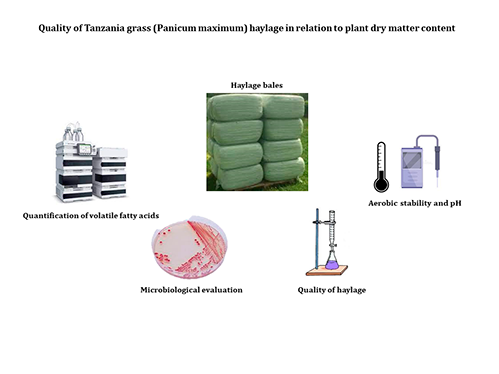Quality of Tanzania grass (Panicum maximum) haylage in relation to plant dry matter content
DOI:
https://doi.org/10.48162/rev.39.094Keywords:
conservation, haylage , grasses, microbiology, moisture , Tanzania grassAbstract

This study aimed to evaluate the quality of Tanzania grass (Panicum maximum) haylage with varying contents of dry matter (DM) and stored for 90 days. The quality of this grass was evaluated through the lens of a variety of physiochemical properties (e.g., chemical composition, aerobic stability, pH, microbial profile, etc.). A completely randomized design was used with four treatments (in natura, 400, 500, and 600 g kg-1 DM) and five replicates. Treatment with 600 g kg-1 DM yielded the highest DM haylage (p < 0.01) and soluble carbohydrate content (p < 0.01). Treatment in natura resulted in the highest O2
concentration inside the bales (p < 0.01), whereas treatments with 500 and 600 g kg-1 DM resulted in the highest CO2 values. The highest acetic acid concentrations of 36.4 ± 1.6, 38.2±1.6, and 48.9 ± 1.6 g kg-1 DM (p < 0.01) were observed post the in natura, 500 g kg-1 DM, and 600 g kg-1 DM treatments, respectively. Treatment with 600 g kg-1 DM yielded the highest pH value at hour zero (p < 0.01). Tanzania grass with 500 and 600 g kg-1 DM produced the highest quality haylage.
Highlights:
- Haylage can be defined as stored pre-dried forage with a dry matter (DM) content of approximately 400 to 800 g/kg.
- Aerobic stability was affected by the interaction between the different plant DM contents and hours of exposure of the Tanzania grass haylage to air after opening the bales.
- Haylage surface temperature has a linear relationship with the length of time the materials are exposed to air.
- Higher plant DM yields Tanzania grass haylage of high quality.
- Tanzania grass with 500 and 600 g kg-1 DM for haylage production is indicated.
Downloads

Downloads
Published
How to Cite
Issue
Section
License
Copyright (c) 2018 Revista de la Facultad de Ciencias Agrarias UNCuyo

This work is licensed under a Creative Commons Attribution-NonCommercial-ShareAlike 3.0 Unported License.
Aquellos autores/as que tengan publicaciones con esta revista, aceptan las Políticas Editoriales.










.jpg)




